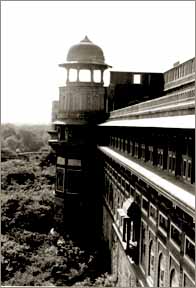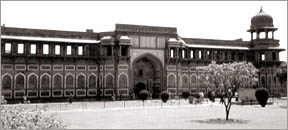|
observer |
|
|
|
|
|
OTHER LINKS |

|

|

|
Agra FortSomething beyond romance :
The original `Red Fort' (although that title has since been usurped by the more well-known fort in Delhi), the fort at Agra stands next to what is perhaps India's best known monument, the Taj Mahal. More often than not, the Agra Fort is overshadowed by the pristine beauty of the Taj, but for those looking for something beyond romance, the Agra Fort is worth seeing Akbar, the greatest empire-builder of the Mughals, commissioned the Agra Fort in 1565, and his grandson Shah Jahan, pulled down many of the original buildings and replaced them with marble ones, while Aurangzeb added the ramparts. The fort was for some time occupied by the British; today, much of it is with the Indian Army and is out of bounds for tourists. The main point of entry for tourists to the Agra Fort is the Amar Singh Gate; the main entrance, the Delhi Gate, is now closed. Once past the gate, some of the fort's most splendid architectural structures are on view: keep your camera ready. The first of these is the Diwan-e-Aam (the Hall of Public Audience), a pillared hall centred round a throne alcove of marble with a delicate pietra dura inlay of floral motifs. The throne alcove was initially made to house the Peacock Throne (which was later taken to Delhi by Shah Jahan, looted by Nadir Shah and then carried away to Persia).
Like the Diwan-e-Aam, the Diwan-e-Khas, where the emperor held audience with visiting dignitaries, is also splendid. Built in 1635, it had two thrones on the terrace, one in white marble and one in black slate. Emperor Shah Jahan is believed to have used the marble throne for repose, and the slate throne to watch elephant fights in the courtyard. Other than these, the fort's main structures include the Khas Mahal, where the emperor slept (the Khas Mahal has cavities in its flat roof to insulate it from the hot winds of summer) and the Macchi Bhawan, or fish chamber, with its fountains, tanks and water channels stocked with fish. The emperor and his courtiers amused themselves by angling here. Also within the fort is the marble Nagina Masjid, built by Shah Jahan to house the women of the zenana or harem. Below it is the Zenana Meena Bazaar, where the ladies could examine and buy trinkets, finery and the like- all without actually emerging from their purdah (veil). The Sheesh Mahal (the Palace of Mirrors) has mirrored walls, which reflected and enhanced the lamplight, and was used by the women for bathing. Last but not least is the two-storied octagonal tower known as the Musamman Burj, said to be the place from where Shah Jahan last saw his beloved Taj Mahal before dying. Best time to go The best time to visit Agra is in winter- between November and March, when the weather's at its best and the city plays host to some interesting festivals. Of these, arts and crafts fair known as the Taj Mahotsav (February 18-27) is perhaps the best-known, although the Sharadotsav (October), a cultural festival featuring famous performers from across India, is also worth attending. The Agra Fort is open to visitors from sunrise to sunset. Getting there and aroundDefinitely among India's top tourist destinations, Agra is well connected to the rest of the country by air, rail and road. Domestic flights link it to Delhi, Khajuraho and Varanasi, while trains from a number of cities arrive at Agra's six railway stations (of which Agra Cantonment is the largest, receiving trains from Southern India, Delhi, Gwalior and Jhansi, among others). For those coming from Delhi, the Shatabdi Express (which arrives in Agra at 9 am and returns at 8.15 pm) is very convenient. By road, Agra is linked to Mathura (56 kms), Delhi (203 kms), Gwalior (118 kms), Jaipur (237 kms) and several other major cities. UPSRTC and private buses ply to and from Agra and other cities, using the Idgah Bus Stand as the main terminus. Within Agra, the wisest option for getting around is to hire a chauffeur-driven car to take you around the sights. Local buses are available, but are crowded and unreliable. For a spot of local colour, try a cycle rickshaw or an auto rickshaw; but bargain- or you may be taken literally for a ride! AccommodationAgra has loads of choices when it comes to tourist accommodation- the city has a number of 5-star deluxe hotels, many of them vying to offer you a great view of the Taj. Most of these are located in the quieter Cantonment area and the new Tourist Complex, while the cheaper budget accommodation is in Taj Ganj. They're great money-savers, although you should be prepared for crowds and noise; among the other options for low-budget living are the campsites and paying guest accommodations in town. (courtesy: www.journeymart.com) |









